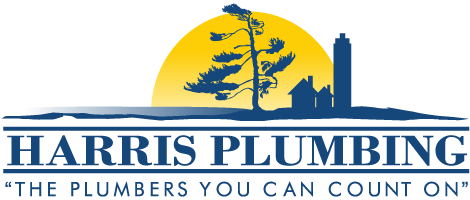Your plumbing system is made up of many pipes, valves, and faucets that work together to keep water flowing in and out of your home or commercial building.
The below diagram serves as an example of how a residential plumbing system should be set up to provide proper plumbing throughout your home. However, depending on the layout and age of your building, this plumbing diagram may become more complex. This is especially true for apartment complexes, restaurants, and commercial buildings with unique plumbing needs.
Curious about how your specific system works? Call the team at Harris Plumbing today at 1-866-786-1801. We can provide helpful plumbing analysis and services to Barrie, Orillia, Muskoka, Huntsville, Aurora, Newmarket, and Georgina.


Which Pipes Do What?
Based on the above diagrams, your plumbing pipes function in the following ways:
- Blue lines = fresh water supply entering the building
- Red lines = hot water supply entering the building
- Grey lines = pipes carrying waste away from the building and venting pipes carrying gases away from the building (through the roof)
Your Main Plumbing Systems
There are two main plumbing systems that support your home’s basic plumbing needs – one that brings clean water into your home, and one that sends dirty water away from your home. Connected to the toilet, bath, shower, and other faucets in your home, these two systems keep your water flowing in the right directions.
Accessing Fresh Water
Fresh and clean water is brought into your home through the “main water supply line”. Filtered through one pipe, this water is pressured to flow into the various fixtures in your home at any given time.
This water can be sourced from a well located on your property, a pond or river (mostly cottages), or, as in most cases, from the city’s municipal water treatment centre. However, it is important to note that water that is untreated, such as the water siphoned from ponds or rivers, may not be safe to drink. Personal water supplies always need to be treated for hardness and contaminants before consumed.
Municipal Water Supplies
Municipal water is taken from nearby bodies of water and is treated to ensure that the water meets standards set forth by the municipality or province/territory. To further treat water, many homeowners install water filtrations systems that:
- Improve taste and odour
- Remove sediment
- Eliminate hardness
- Reduce chlorine
To address your water filtration concerns, it is always best to contact a trusted plumber who can provide you will all of the knowledge you’ll need to make an educated decision on a water filtration system. Your trusted plumber can also provide a safety test, which will examine the contaminants in your water.
Cold Water Supply Vs. Hot Water Supply
Cold water flows into your home or building through the service line, which then distributes hot or cold water to your fixtures. This line is most commonly run through a central column that runs floor to floor. Hot water runs in short and straight pipes – as the longer the pipeline, the more heat that will be lost in the transfer. Having shorter pipes also allows residents to access hot water more quickly.
Hot water is either heated through an electric or gas hot water tank or a more modern, space-sensitive, and efficient tankless water heater.
Waste Water System
Your wastewater system is divided into two parts – pipes that send wastewater away from your home and venting pipes that send sewer gas away from your home. Sewage water travels through pipes that flush the water and waste towards local sewers that are operated and managed by your city or town. Most sewer systems rely on gravity to move the wastewater to where it needs to go.
The further away from your toilet or sink, the larger wastewater pipes become. This allows for waste to be disposed of from various parts of your home or business at once – without pipe blockages. The angle and flow of these pipes are also essential for keeping your waste pipes clear of build up.
For more information concerning your water and plumbing systems, take a look at our helpful collection of sewer and septic line resources:
Sewer Gas Venting
Your household and commercial plumbing systems need to breathe to work correctly. Venting pipes, which travel through your building and out through the roof, work to relieve any sewer gas that could potentially linger or become trapped in your home.
Gas traps and venting systems also prevent smelly gases from entering the home as well as dangerous microbes that can make you very sick.
Identifying Problems with Your Plumbing System
If your water for some reason isn’t flowing, it is likely that you are experiencing a pipe blockage, break, or issue. If this occurs, call your local plumber to assess and determine an efficient solution that will restore your water flow.
As identified in our article, ‘6 Signs You Need a Sewer Replacement’, below are a few signs you’ll need to have your plumbing investigated:
- Slow draining
- Foundational cracks
- Moulding
- Rodent and insect issues
- Septic waste in your yard
- Sewage back up
Have a question? We’re here to help! Call the team at Harris Plumbing today at 1-866-786-1801. We can provide helpful plumbing analysis and services to Barrie, Orillia, Muskoka, Huntsville, Aurora, Newmarket, and Georgina.

